The Great Horned Owl (Bubo virginianus), a majestic and formidable bird of prey, commands attention with its distinctive features and impressive stature.
Renowned for its nocturnal prowess, this iconic owl species holds a prominent place in the avian world.
Characterized by ear tufts, often mistaken for horns, and a striking facial disk, the Great Horned Owl exhibits a robust and adaptable nature.
With a broad geographic range spanning North and South America, from Arctic regions to tropical rainforests, it showcases remarkable versatility in habitat selection.
Recognized for its deep hooting calls resonating through the night, the Great Horned Owl is a symbol of wisdom and stealth.
Its ability to thrive in various environments, coupled with powerful hunting skills and dedicated parental care, solidifies its status as a captivating and integral member of the avian ecosystem.
The Great Horned Owl’s presence in both wilderness and urban landscapes makes it a subject of fascination and admiration for bird enthusiasts and nature lovers alike. Best of luck.
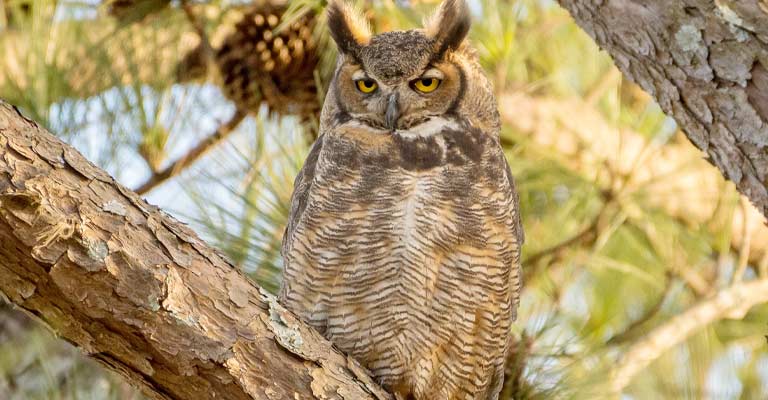
Taxonomy of Great Horned Owl
Here is a table summarizing the taxonomy details of the Great Horned Owl:
| Taxonomic Level | Classification |
| Domain | Eukaryota |
| Kingdom | Animalia |
| Phylum | Chordata |
| Class | Aves |
| Order | Strigiformes |
| Family | Strigidae |
| Genus | Bubo |
| Species | B. virginianus |
The Great Horned Owl (Bubo virginianus) belongs to the family Strigidae, encompassing various owl species worldwide.
Within this family, the genus Bubo includes the eagle owls, and Bubo virginianus is the specific species known as the Great Horned Owl.
These large and powerful birds share common characteristics, including tufted “horns,” prominent facial disks, and a robust build.
As adaptable and skilled predators, their taxonomy places them within the diverse and widespread owl family, where they play crucial roles in maintaining ecological balance through their nocturnal hunting habits and distinctive behaviors.
Physical Characteristics of Great Horned Owl
The Great Horned Owl (Bubo virginianus) is a majestic and powerful bird of prey, known for its distinctive physical characteristics that make it easily identifiable in the wild.
Here are some of the key points to help you recognize and appreciate the unique features of this magnificent owl:
Size and Shape
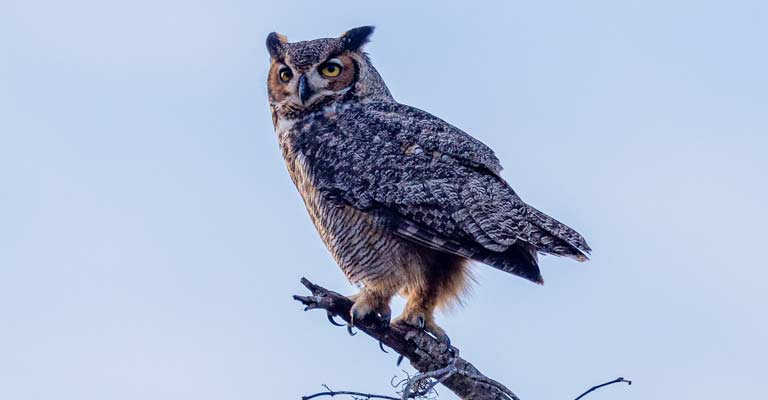
The Great Horned Owl is a large bird, measuring between 18 to 25 inches in length and boasting an impressive wingspan of 3.3 to 4.8 feet.
Its robust and compact build gives it a formidable appearance, making it one of the largest owl species in North America.
Ear Tufts
One of the most noticeable features of the Great Horned Owl is its prominent ear tufts, which are not ears but rather feather tufts that stand upright on either side of its head.
These tufts, also known as “horns” or “ear-like extensions,” contribute to its distinct silhouette and aid in camouflage.
Facial Disk
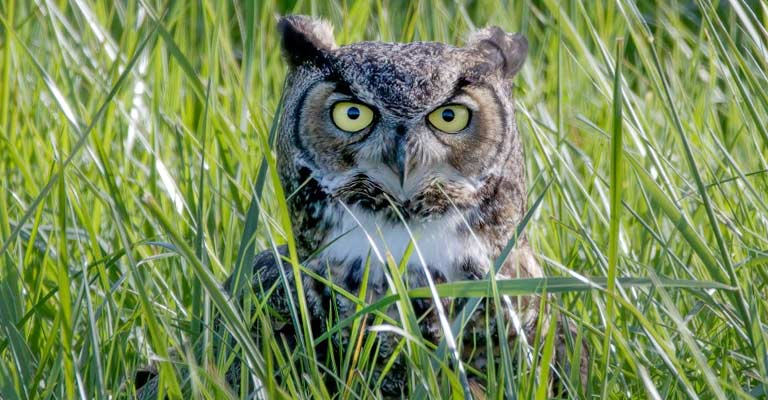
The owl’s facial disk is a defining characteristic, designed to funnel sound waves toward its ears for exceptional hearing.
The disk is marked by a pattern of concentric circles of feathers, giving the owl an expressive and captivating visage.
The coloration of the facial disk varies from individual to individual, ranging from light gray to reddish-brown.
Coloration
Great Horned Owls exhibit a wide range of color variations in their plumage, which serves as effective camouflage in different habitats.
Generally, they have mottled brown and gray feathers with distinct horizontal barring on their chests and vertical streaks on their bellies. This cryptic coloration aids in blending seamlessly with their surroundings.
Large, Yellow Eyes
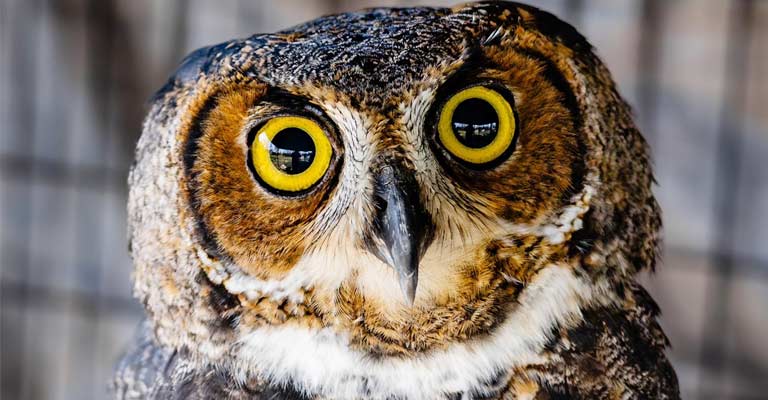
The owl’s large, bright yellow eyes are striking and provide excellent low-light vision.
Their keen eyesight allows them to hunt effectively during dawn and dusk, making them formidable nocturnal predators. The intense gaze of their eyes adds to the owl’s overall captivating appearance.
Powerful Talons
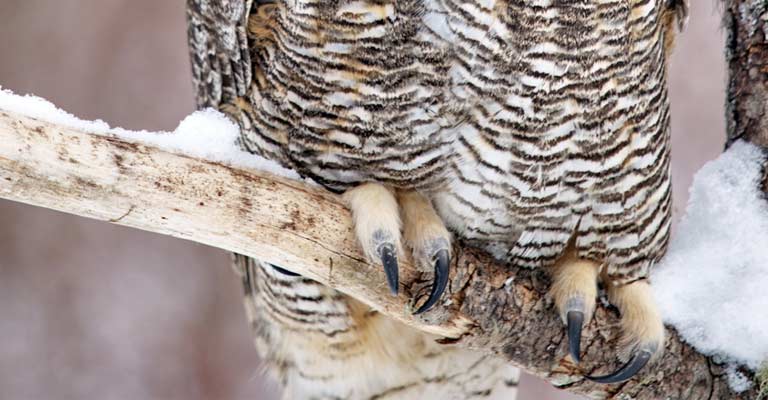
The Great Horned Owl possesses strong and sharp talons adapted for catching and grasping prey.
These formidable weapons, along with their powerful beak, enable them to capture a wide range of prey, from small mammals to birds.
Distinctive Hooting Call
The vocalizations of the Great Horned Owl are iconic, featuring a deep and resonant hooting sound.
Their calls vary in pitch and rhythm, and these vocalizations are often used to establish territory or communicate with a mate during the breeding season.
Habitat and Range
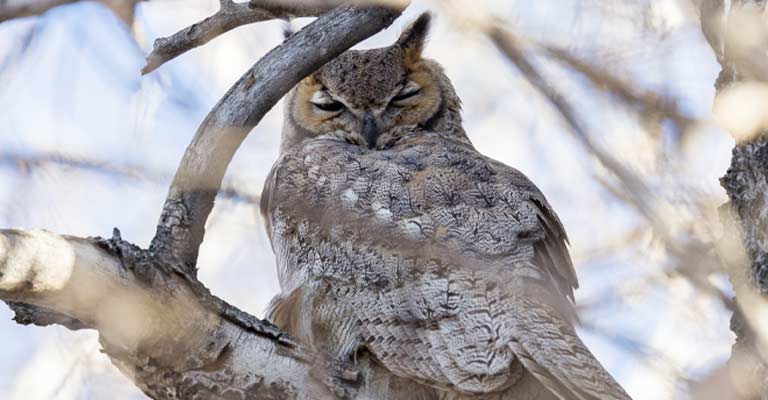
Great Horned Owls are highly adaptable and can be found in a variety of habitats, including forests, deserts, and urban areas.
Their extensive range spans throughout North and South America, showcasing their adaptability to diverse environments.
The Great Horned Owl’s physical characteristics, including its size, ear tufts, facial disk, coloration, eyes, talons, distinctive calls, and habitat, collectively contribute to its unique and easily recognizable presence in the avian world.
Observing these magnificent birds in the wild provides a rare opportunity to witness the beauty and prowess of one of nature’s most accomplished predators.
Great Horned Owl’s Common Food
The Great Horned Owl is a versatile and opportunistic predator with a varied diet, showcasing its adaptability to different ecosystems.
Here are some key points regarding the common food sources of the Great Horned Owl:
- Small Mammals: Great Horned Owls are skilled hunters of small mammals, including rodents like mice, voles, rats, and shrews. They are also known to prey on larger mammals such as rabbits and hares.
- Birds: Birds constitute a significant portion of the Great Horned Owl’s diet. They are known to hunt a variety of bird species, ranging from songbirds and waterfowl to larger birds like grouse and pheasants.
- Amphibians and Reptiles: These owls are opportunistic feeders, and their diet may include amphibians like frogs and reptiles such as snakes and lizards. Their adaptability extends to various types of prey in their environment.
- Insects: While not a primary food source, Great Horned Owls may supplement their diet with insects, especially during periods when other prey is scarce. Insects can include beetles, moths, and grasshoppers.
- Fish: In certain habitats, particularly near water bodies, Great Horned Owls may catch fish. They are capable of swooping down to the water’s surface to seize fish with their powerful talons.
- Carrion: Great Horned Owls are known to scavenge on occasion, feeding on carrion and taking advantage of opportunities presented by already deceased animals.
- Crustaceans and Invertebrates: In some regions, these owls may consume crustaceans and various invertebrates, broadening their diet to include crayfish and insects found in aquatic environments.
- Domestic Animals: In urban or suburban settings, Great Horned Owls may prey on domestic animals such as small dogs and cats, particularly if these pets are left unattended outdoors during the night.
The Great Horned Owl’s ability to adapt its diet based on the availability of prey contributes to its success as a formidable and resourceful predator in a wide range of habitats.
Great Horned Owl Life History
The Great Horned Owl (Bubo virginianus), revered for its majestic appearance and nocturnal prowess, boasts a rich life history.
From its habitat preferences to breeding behaviors, nesting habits, and conservation concerns, the life of this impressive raptor is a fascinating journey through diverse ecosystems.
Habitat
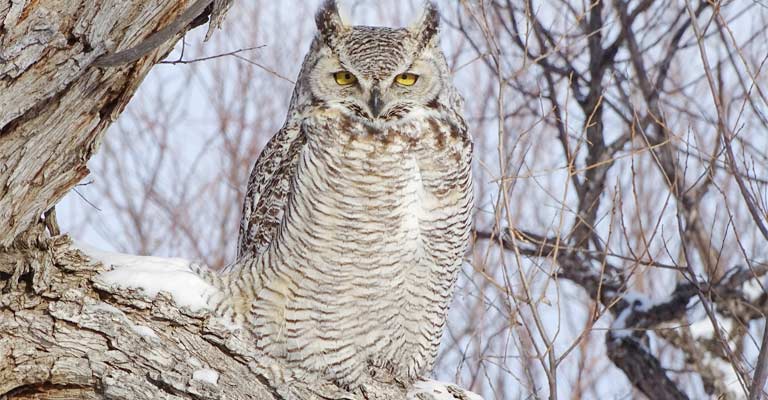
Great Horned Owls are remarkably adaptable and can thrive in a variety of habitats, including forests, deserts, grasslands, and urban areas.
They display a preference for areas with a mix of open spaces for hunting and dense vegetation for roosting and nesting.
Range Map
The range of the Great Horned Owl is extensive, covering a vast expanse of North and South America.
Their distribution spans from the Arctic tundra of Alaska and Canada to the tropical rainforests of Central and South America.
A versatile species, they can be found in both remote wilderness areas and populated urban landscapes.
Breeding
Breeding season for Great Horned Owls typically begins in late winter to early spring.
During this time, courtship displays involve hooting duets between mates, showcasing their strong bond. These owls are known for their monogamous relationships and often mate for life.
Nesting
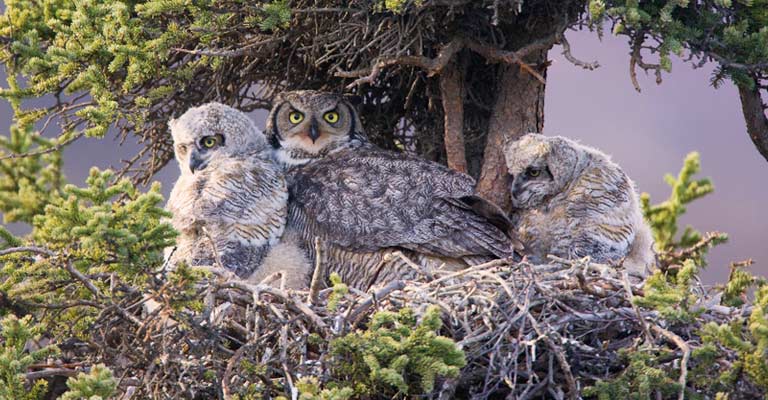
Great Horned Owls are opportunistic nesters, utilizing a variety of natural and abandoned sites for their nests. They may repurpose the nests of other large birds, use tree cavities, or even nest on cliff ledges.
The female is responsible for incubating the eggs, while the male provides food during this critical period.
Here’s a table summarizing the nesting details of the Great Horned Owl:
| Nesting Details | Facts |
| Clutch Size | 1 to 5 eggs (typically 2 or 3) |
| Number of Broods | Usually 1 per year, occasionally 2 |
| Egg Length | Approximately 2.1 to 2.6 inches (5.3 to 6.6 cm) |
| Egg Width | Approximately 1.8 to 2.1 inches (4.5 to 5.3 cm) |
| Incubation Period | Around 30 to 37 days |
| Nestling Period | 6 to 9 weeks |
| Egg Description | White or buff, slightly elliptical shape with a smooth surface |
| Nest Type | Opportunistic, using existing nests or platforms, tree cavities, or cliffs |
| Nest Building | Typically does not construct elaborate nests; may use debris or feathers |
| Incubation Duties | Female primarily incubates eggs, male provides food during incubation |
| Nestling Care | Both parents feed and care for nestlings, female remains with young while male hunts |
| Fledgling Independence | Young owls become independent after leaving the nest, but parents may continue to feed them for some time |
| Nest Site Selection Criteria | Preferences for elevated sites with good visibility for hunting, often near water sources |
These nesting details provide insights into the reproductive behavior and strategies of the Great Horned Owl, emphasizing their adaptability in selecting and utilizing a variety of nesting sites based on environmental conditions and availability.
Diseases
Like many bird species, Great Horned Owls are susceptible to various diseases, including avian pox, aspergillosis, and West Nile virus. These diseases can be detrimental to their health and reproductive success.
Treatment
Conservation efforts often involve monitoring the health of Great Horned Owl populations and implementing treatment strategies when diseases are detected.
Rehabilitation centers play a crucial role in providing medical care and rehabilitation for injured or diseased owls, contributing to their overall well-being.
Conservation
While Great Horned Owls are not currently listed as a species of concern, habitat loss, pesticide exposure, and human-related threats can impact their populations.
Conservation efforts focus on preserving diverse habitats, ensuring the availability of suitable nesting sites, and educating the public about the importance of coexisting with these magnificent birds.
The life history of the Great Horned Owl is a testament to its adaptability and resilience.
From the choice of habitat to the intricacies of breeding and the challenges posed by diseases, understanding and conserving the life of this iconic owl is vital for maintaining the balance of ecosystems across the Americas.
Behavioral Habits of Great Horned Owl
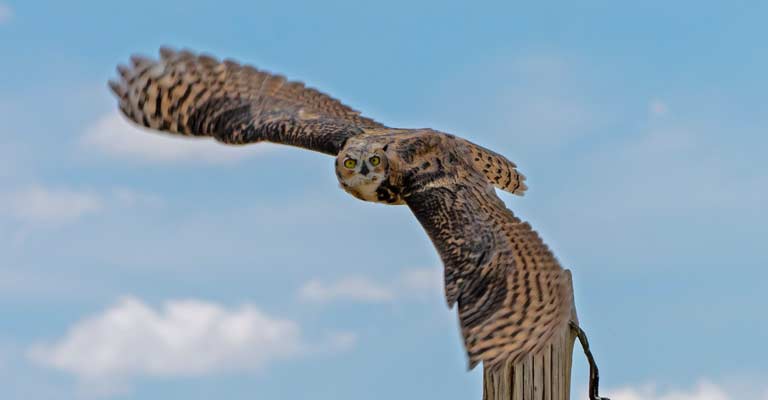
The behavioral habits of the Great Horned Owl (Bubo virginianus) are fascinating and reflect the adaptability and intelligence of this nocturnal predator. Here are some key aspects of their behavioral habits:
Nocturnal Hunting
Great Horned Owls are primarily nocturnal, meaning they are most active during the night. Their exceptional night vision and keen hearing make them highly efficient hunters in low-light conditions.
Territorial Nature
Great Horned Owls are territorial birds, and they establish and defend their territories, especially during the breeding season. Territorial disputes often involve vocalizations and displays to assert dominance.
Solitary Behavior
While they may form monogamous pairs during the breeding season, outside of this period, Great Horned Owls generally exhibit solitary behavior. They are known to be solitary hunters and roosters.
Distinctive Vocalizations
The hooting calls of the Great Horned Owl are iconic and play a crucial role in communication. Mates engage in hooting duets during courtship, and territorial calls help establish boundaries.
Camouflage and Stealth
Great Horned Owls possess excellent camouflage, with their mottled plumage resembling tree bark. Their ability to perch quietly and move stealthily allows them to surprise and capture prey efficiently.
Powerful Flight
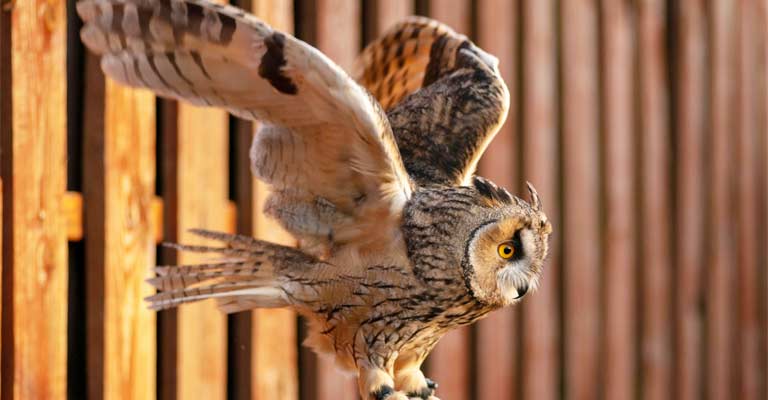
These owls are powerful fliers, and their broad wings and strong wing beats enable them to cover large distances. They are adept at gliding silently through the air when hunting.
Varied Diet and Hunting Techniques
Great Horned Owls are opportunistic hunters with a diverse diet. They can capture a wide range of prey, including mammals, birds, reptiles, amphibians, and even invertebrates.
Their hunting techniques include perching and waiting, as well as actively searching for prey on the ground.
Parental Care
The parental care of Great Horned Owls is remarkable. Both parents contribute to raising the young, with the female primarily responsible for incubating the eggs and brooding the nestlings.
The male plays a crucial role in providing food for the family.
Adaptability to Urban Environments
Great Horned Owls are known for their adaptability to urban settings. They may nest in parks, and wooded areas within cities, and even use artificial structures like buildings and ledges for roosting.
Aggressive Defense
Great Horned Owls are known to be fiercely protective of their nests and young. They can display aggressive behavior when threatened, using their talons and beaks to defend against predators.
Understanding the behavioral habits of the Great Horned Owl provides valuable insights into its role as a top predator, its interactions with its environment, and the strategies it employs for survival in diverse ecosystems.
Wrapping Up
The Great Horned Owl, with its majestic appearance and versatile behaviors, stands as a remarkable predator in diverse ecosystems.
From its nocturnal hunting prowess and distinctive vocalizations to its adaptability in urban environments and dedicated parental care, this iconic bird of prey showcases the intricacies of nature’s design.
The Great Horned Owl’s resilience and territorial nature underscore its vital role in maintaining ecological balance.
As a symbol of wisdom and stealth, its behavioral habits offer a glimpse into the wonders of avian life, emphasizing the importance of conservation for the well-being of this magnificent species and the ecosystems it inhabits. Best of luck.